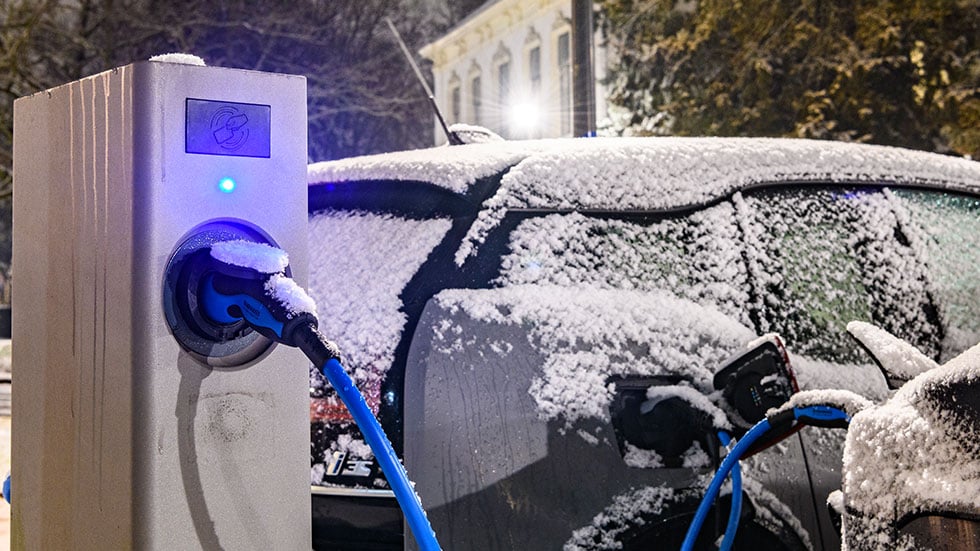How Do I Store an Electric Vehicle Over the Winter?
Tips to protect your electric vehicle battery in storage


James MacPherson
November 18, 2022·3 min read
Q: We are heading south for the winter and leaving our new Hyundai Ioniq 5, an electric vehicle, at our Connecticut home for six months. What do we need to do to protect the battery?
A: Storing an electric vehicle (EV) is possible if you take the proper precautions. Start by noting that most EVs have two batteries. The high-voltage “traction battery” powers the electric motors that move the car, while a standard 12-volt battery is used for everything else: lights, wipers, horn, etcetera. Both batteries must be protected, and this is where things can become a little complicated. Not all manufacturers agree on long-term EV storage requirements.
While it may seem counterintuitive, Hyundai recommends storing the car with the high-voltage battery holding less than a full charge. When asked about storage requirements, a representative of the manufacturer wrote in an email, “the vehicle [should] be stored with the main battery pack at 70–80 percent state of charge. This will ensure that the Auxiliary Battery Saver+ function will keep the 12V battery maintained over time.”

Other EV makers recommend a lesser charge. For example, the Ford Mustang Mach-E owner’s manual reads, “When you park your vehicle for an extended period of 30 days or more, we recommend your battery be at an approximately 50 percent state of charge. Storing your vehicle’s high-voltage battery at higher states of charge is less favorable than storing [it] at lower states of charge.”
Then, there is the 12-volt battery. Normally, the high-voltage battery keeps the 12-volt charged. Since this will deplete the high-voltage battery’s charge over the winter, however, some people connect a battery tender to the 12-volt battery or disconnect the 12-volt battery completely.
These varying recommendations mean that EV owners planning to store their vehicle must check with the manufacturer for definitive instructions. If the owner’s manual is unclear, call the manufacturer or a dealer for clarification.
Some recommend that you completely shut down the vehicle. The steps needed to do this vary, so once again, read the owner’s manual first. Other automakers suggest that you leave the car plugged in to a Level 1 or Level 2 charger. For those who leave the car plugged in, it may be possible to control the charging process using an app.
For maximum battery protection, Ford suggests storage at temperatures between 32- and 113-degrees Fahrenheit. In colder climates, this means garaging the car. Be sure to clean the car before parking it in a rodent-free garage to avoid nesting rodents damaging wiring.
Ultimately, you may want to consider having a trusted friend or family member use the car and recharge it every week or so during your absence. (Check with your auto insurance provider to ensure your coverage would extend to that driver.) Either way, taking the proper steps as outlined by the automaker should lessen your worries about leaving your car this winter.
A: Storing an electric vehicle (EV) is possible if you take the proper precautions. Start by noting that most EVs have two batteries. The high-voltage “traction battery” powers the electric motors that move the car, while a standard 12-volt battery is used for everything else: lights, wipers, horn, etcetera. Both batteries must be protected, and this is where things can become a little complicated. Not all manufacturers agree on long-term EV storage requirements.
While it may seem counterintuitive, Hyundai recommends storing the car with the high-voltage battery holding less than a full charge. When asked about storage requirements, a representative of the manufacturer wrote in an email, “the vehicle [should] be stored with the main battery pack at 70–80 percent state of charge. This will ensure that the Auxiliary Battery Saver+ function will keep the 12V battery maintained over time.”

Other EV makers recommend a lesser charge. For example, the Ford Mustang Mach-E owner’s manual reads, “When you park your vehicle for an extended period of 30 days or more, we recommend your battery be at an approximately 50 percent state of charge. Storing your vehicle’s high-voltage battery at higher states of charge is less favorable than storing [it] at lower states of charge.”
Then, there is the 12-volt battery. Normally, the high-voltage battery keeps the 12-volt charged. Since this will deplete the high-voltage battery’s charge over the winter, however, some people connect a battery tender to the 12-volt battery or disconnect the 12-volt battery completely.
These varying recommendations mean that EV owners planning to store their vehicle must check with the manufacturer for definitive instructions. If the owner’s manual is unclear, call the manufacturer or a dealer for clarification.
Some recommend that you completely shut down the vehicle. The steps needed to do this vary, so once again, read the owner’s manual first. Other automakers suggest that you leave the car plugged in to a Level 1 or Level 2 charger. For those who leave the car plugged in, it may be possible to control the charging process using an app.
For maximum battery protection, Ford suggests storage at temperatures between 32- and 113-degrees Fahrenheit. In colder climates, this means garaging the car. Be sure to clean the car before parking it in a rodent-free garage to avoid nesting rodents damaging wiring.
Ultimately, you may want to consider having a trusted friend or family member use the car and recharge it every week or so during your absence. (Check with your auto insurance provider to ensure your coverage would extend to that driver.) Either way, taking the proper steps as outlined by the automaker should lessen your worries about leaving your car this winter.
Share
